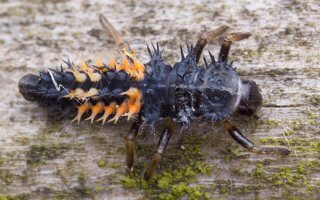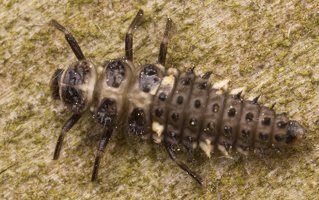- sort orderDefault
Photo title, A → Z
Photo title, Z → A
✔ Date created, new → old
Date created, old → new
Date posted, new → old
Date posted, old → new
Visits, high → low
Random - Google Map
- map
 home / Insecta · vabzdžiai / Coleoptera · vabalai / Coccinellidae · boružės / ~ Coccinellidae larvae · boružių lervos
home / Insecta · vabzdžiai / Coleoptera · vabalai / Coccinellidae · boružės / ~ Coccinellidae larvae · boružių lervos

-
 Harmonia axyridis larva · azijinė boružė, lerva
Harmonia axyridis larva · azijinė boružė, lerva
-
 Ceratomegilla notata larva · dilgėlinė boružė, lerva
Ceratomegilla notata larva · dilgėlinė boružė, lerva
-
 Chilocorus renipustulatus larva · juodbruvėlė boružė, lerva
Chilocorus renipustulatus larva · juodbruvėlė boružė, lerva
-
 Chilocorus renipustulatus larva · juodbruvėlė boružė, lerva
Chilocorus renipustulatus larva · juodbruvėlė boružė, lerva
-
 Chilocorus renipustulatus larva · juodbruvėlė boružė, lerva
Chilocorus renipustulatus larva · juodbruvėlė boružė, lerva
-
 Propylaea quatuordecimpunctata larva · juodasiūlė boružė, lerva
Propylaea quatuordecimpunctata larva · juodasiūlė boružė, lerva
-
 Propylaea quatuordecimpunctata larva · juodasiūlė boružė, lerva
Propylaea quatuordecimpunctata larva · juodasiūlė boružė, lerva
-
 Propylaea quatuordecimpunctata larva · juodasiūlė boružė, lerva
Propylaea quatuordecimpunctata larva · juodasiūlė boružė, lerva
-
 Propylaea quatuordecimpunctata larva · juodasiūlė boružė, lerva
Propylaea quatuordecimpunctata larva · juodasiūlė boružė, lerva
-
 Calvia quatuordecimguttata larva · keturiolikadėmė boružė, lerva
Calvia quatuordecimguttata larva · keturiolikadėmė boružė, lerva
-
 Calvia quatuordecimguttata larva · keturiolikadėmė boružė, lerva
Calvia quatuordecimguttata larva · keturiolikadėmė boružė, lerva
-
 Calvia quatuordecimguttata larva · keturiolikadėmė boružė, lerva
Calvia quatuordecimguttata larva · keturiolikadėmė boružė, lerva
-
 Adalia bipunctata larva · dvitaškė adalija, lerva
Adalia bipunctata larva · dvitaškė adalija, lerva
-
 Coccinellidae larva · boružės lerva
Coccinellidae larva · boružės lerva
-
 Coccinellidae larva · boružės lerva
Coccinellidae larva · boružės lerva
-
 Coccinella septempunctata larva · septyntaškė boružė, lerva
Coccinella septempunctata larva · septyntaškė boružė, lerva
-
 Coccinella septempunctata larva · septyntaškė boružė, lerva
Coccinella septempunctata larva · septyntaškė boružė, lerva
-
 Psyllobora vigintiduopunctata larva · dvidešimtdvitaškė boružė, lerva
Psyllobora vigintiduopunctata larva · dvidešimtdvitaškė boružė, lerva
-
 Propylaea quatuordecimpunctata larva · juodasiūlė boružė, lerva
Propylaea quatuordecimpunctata larva · juodasiūlė boružė, lerva
-
 Propylaea quatuordecimpunctata larva · juodasiūlė boružė, lerva
Propylaea quatuordecimpunctata larva · juodasiūlė boružė, lerva
-
 Subcoccinella vigintiquatuorpunctata larva · dvidešimtketurtaškė boružė, lerva
Subcoccinella vigintiquatuorpunctata larva · dvidešimtketurtaškė boružė, lerva
-
 Subcoccinella vigintiquatuorpunctata larva · dvidešimtketurtaškė boružė, lerva
Subcoccinella vigintiquatuorpunctata larva · dvidešimtketurtaškė boružė, lerva
-
 Coccinella septempunctata larva · septyntaškė boružė, lerva
Coccinella septempunctata larva · septyntaškė boružė, lerva
-
 Coccinella septempunctata larva · septyntaškė boružė, lerva
Coccinella septempunctata larva · septyntaškė boružė, lerva
-
 Propylaea quatuordecimpunctata larva · juodasiūlė boružė, lerva
Propylaea quatuordecimpunctata larva · juodasiūlė boružė, lerva
-
 Psyllobora vigintiduopunctata larva · dvidešimtdvitaškė boružė, lerva
Psyllobora vigintiduopunctata larva · dvidešimtdvitaškė boružė, lerva
-
 Subcoccinella vigintiquatuorpunctata larva · dvidešimtketurtaškė boružė, lerva
Subcoccinella vigintiquatuorpunctata larva · dvidešimtketurtaškė boružė, lerva
-
 Subcoccinella vigintiquatuorpunctata larva · dvidešimtketurtaškė boružė, lerva
Subcoccinella vigintiquatuorpunctata larva · dvidešimtketurtaškė boružė, lerva
-
 Subcoccinella vigintiquatuorpunctata larva · dvidešimtketurtaškė boružė, lerva
Subcoccinella vigintiquatuorpunctata larva · dvidešimtketurtaškė boružė, lerva
-
 Calvia quatuordecimguttata larva · keturiolikadėmė boružė, lerva
Calvia quatuordecimguttata larva · keturiolikadėmė boružė, lerva
-
 Calvia quatuordecimguttata larva · keturiolikadėmė boružė, lerva
Calvia quatuordecimguttata larva · keturiolikadėmė boružė, lerva
~ Coccinellidae larvae · boružių lervos
- ladybird beetles, lady beetles, ladybirds, ladybugs
- Marienkäfer
- boružės
- mārīšu dzimta
- biedronkowate
The Coccinellidae larvae moult 3 times (that is they have 4 instars) and after about 3 months they pupate. The prepupal stage (the time between when the ladybug larvae ceases eating and attaches itself to the substrate – and when it actually becomes a pupa in a pupal skin) looks hunched. In most cases, the larval skin is shed as the larva becomes a pupa – but remains wrapped around the posterior (tail) end of the pupa which is attached to the substrate.